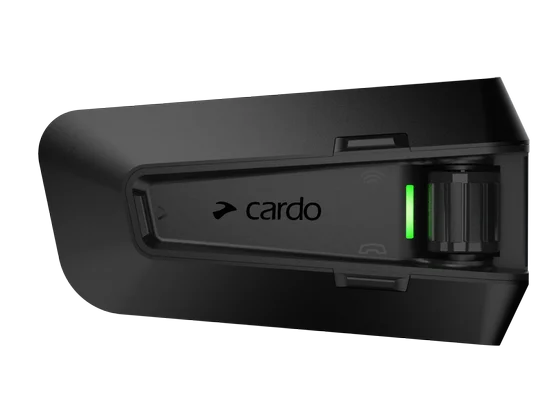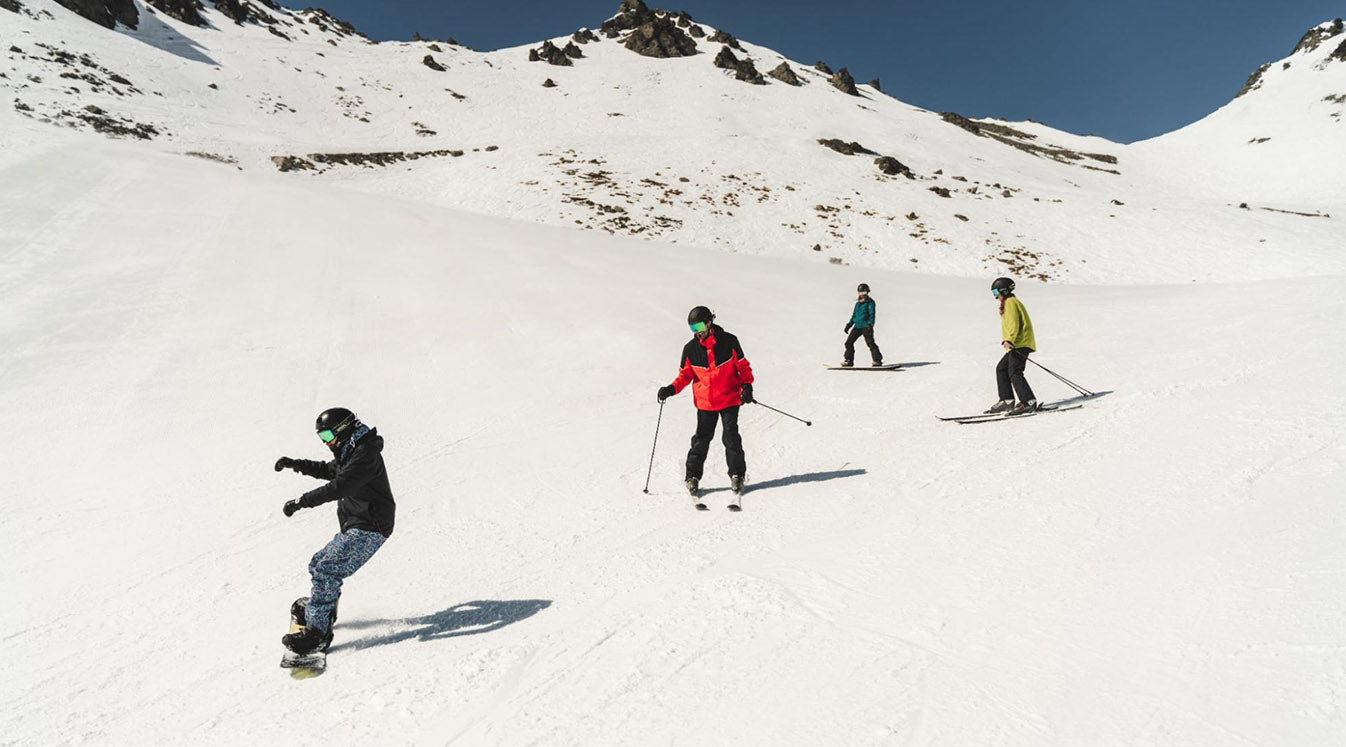Regardless of how you plan on using your motorcycle this winter, it’s always cheaper to maintain your bike than replacing or repairing these essential parts.
Shop Cardo Helmet Communication Systems
Winterizing a motorcycle can be an involved process. We’ll explore some of the best ways to keep the elements at bay so you can ride all year long.
Start with a Plan
Before you go down the list one by one, start by coming up with a plan for winterizing your motorcycle. Make sure you have everything you need to complete the process to last you until spring.

Consider how you plan on using your bike over the course of the season. If you’re an avid rider, you may want to keep riding continuously.
Many riders will hit the road as long as they can until the worst of weather arrives. They’ll pack up their bikes for the coldest months or weeks of the year or as soon as the roads are clear. It all depends on your comfort level and how you plan on getting around.
You should never ride your motorcycle in a snowstorm or blizzard. Riding on snow can be extremely dangerous. The same is true of black ice. Balancing on two wheels is much harder than riding on four. Most round motorcycle tires don’t get enough traction in slick or snowy conditions.
Depending on the local climate, there’s a good chance you’ll have to store your bike for some portion of the winter. It’s only a matter of when and for how long.
If your motorcycle is your only form of transportation, you might want to come up with an alternative for when the snow hits the ground.
Your Winterizing Checklist
Every rider should know how to maintain their bike. However, if you don’t feel comfortable completing some of the steps mentioned below, take your motorcycle to a professional. Experts say having an auto shop winterize your motorcycle usually costs around $200. That’s more than worth it compared to how much you’re saving in potential repairs. Going the DIY route will save you even more money, but you should always consult a professional if you don’t know what you’re doing.
With that in mind, complete these steps to keep your bike in peak condition all winter long:

Treat the Fuel
There are two ways to prepare your gas tank for winter: empty it or use treated fuel to stop the gas from going bad.
If you have a fuel injected motorcycle, there’s no way to empty the fuel tank, so you’ll need to use the latter approach. Grab a jerry can and fill it with fuel stabilizer. This keeps the fuel from going stale, while neutralizing the ethanol that can rust your gas tank.
Top off the gas tank with treated fuel whenever possible to keep it full. This limits the amount of air inside the tank to prevent rust. Let the engine run for a few minutes to make sure the treated gas gets through the system. You’ll have a full tank of gas as soon as you get back on your bike.
If your bike has carburetors and a petcock, you can keep the tank full using the method mentioned above or you can simply drain the fuel system to prevent rust and other forms of decay. However, you’ll need to fill your tank when you feel like going for a ride.
Both methods come with their pros and cons. Keeping the tank full puts more stress on the petcock, but leaving the tank empty can dry out the seals. Make sure you choose one of these options to prevent long-term damage.
Another note for petcocks: Leave the valve in the off position to prevent pressure buildup. If you leave the valve on, the pressure from the fuel tank will wear away at the rubber-tipped needles in the carbs. Fluid may even leak past the needles and into the cylinders over time, which can lead to pooling and poor lubrication.

Cover the Bike
It’s also important to cover your bike regardless of where you plan on storing it for the winter. Your best option is to keep the bike covered while indoors in a climate-controlled environment. If you don’t have a heated garage, consider taking your bike to a self-storage unit to keep it out of the way. It’s much better than leaving it out in the cold.
If you have to leave your bike outside, put it under an awning where it won’t get wet. You should never leave your bike under a tree branch or power line, as the snow could cause them to collapse. Remember that snow is heavy and likely to move over time.
When covering your bike, wrap it up as securely as possible. A plastic tarp is better than nothing. Use bungee cords, weights and other objects to secure the blanket or tarp around the bike. Try to create a weather-proof seal to keep moisture out.
There’s some debate as to whether you should cover your motorcycle when leaving it outside. There’s evidence to suggest that all the excess water from winter will soak into your bike cover, which can dull the paint and damage aluminum nuts and bolts.
When choosing a bike cover, make sure it’s waterproof to keep moisture at bay.
Pest Control
Everyone’s looking for someplace warm in the winter, including mice and rats. These critters can crawl their way into your motorcycle whether it’s indoors or out. They can eat their way through the bike cover and just about anything else that’s made of metal, including wires and air filters. They will even defecate inside your exhaust pipe.
Use plugs to keep these pests from getting inside your motorcycle. For more protection, keep a line of mouse traps nearby.
Start Only When Necessary
A lot of riders will tell you that it’s best to start up your bike once a week during the winter, but that doesn’t tell the full story.
Starting up your motorcycle in the winter, also known as a cold start, is generally rough on the engine, so starting it up for no reason doesn’t really make a lot of sense.
This can also damage the battery. The bike only charges when it ramps up to a normal RPM. Most bikes don’t charge the battery when sitting idle. If you’re trying to charge the battery, it’s best to take the bike for a short 20-minute ride instead.
Leaving the bike idling can also bring in condensation. The engine won’t reach normal operating temperatures, which can lead to excess moisture as warm air collides with the cold.

Battery Maintenance
The cold weather can be hard on your battery. Traditional lead-based batteries can leak over time. Most units will also lose power as the months wear on, which can leave you with a dead battery come spring.
Many riders recommend installing a SAE for easy access to the battery. You can also use it to power additional electronics, including heated gear, GPS and your phone charger. Connect the battery to a smart charger or crank and periodically charge it over time.
When charging your battery, make sure you use a smart charger that will only give it juice when it needs it. If you charge the battery too much, it could lead to long-term damage.
Lithium-ion batteries come with a low discharge rate. They can typically sit idle for months on end without losing much of a charge.
If you’re not riding during the winter, consider disconnecting the battery and bringing it indoors. Use a small float charger to keep it full.
Protect the Surface
Before you swaddle up your bike for winter, don’t forget to clean it. You don’t want all those dead bugs and excess dirt sitting on your bike for months. This debris can lead to rust and oxidation over time.
Once it’s dry, apply wax to the painted parts to keep it looking its best. Apply a silicone protectant to plastic panels. Use aerosol lubricant on chromed, polished or anodized metal components. This will protect these parts from rust.
Finally, remember to clean and lubricate your motorcycle chain before putting it away.
Change the Oil
Use caution when filling up your engine with oil. Some riders will tell you to fill it up at the start of winter and again at the start of spring, but this isn’t always necessary.
Experts say you need to change the oil between every 5,000 to 8,000 miles. If you’re more than halfway there, go ahead and add oil now before winter arrives. This will give you plenty of oil when spring arrives.
If you recently changed the oil or aren’t at the halfway point, you might not need to change your oil, especially if you’re not doing much driving.
Fill the Tires
You will also want to make sure the tires are fully – and not over – inflated. Air pressure will slowly decrease over time if the bike is standing on the ground. Get it up on the racks so your tires aren’t loaded.
If you don’t have stands, be sure to occasionally roll the tires forward and back to prevent settling and flat spots. Use a tire air pressure gauge to keep them fully inflated all season long.

Helmet Communication
You can never be too careful when riding in the winter. If you’re one of those types who can’t stand to be away from the road for more than a few weeks, you’ll need some form of helmet communication.
Use a motorcycle Bluetooth headset to stay in touch with your loved ones and other riders. You can connect several riders onto the same channel for instant, hands-free communication. Instantly call for help using your voice if you get into an accident. You don’t have to worry about pulling over and taking your phone out of your pocket.
Stay on top of everything that’s happening on and off the road with a pair of Bluetooth motorcycle speakers that fit right into your helmet.
Knowing when to pack up your motorcycle for the season can be difficult. It’s always better to err on the side of caution and keep your bike in storage when the snow starts to fall. Riding around in the rain is usually dangerous enough. Use these tips to keep your motorcycle running at peak efficiency before, during and after winter.
You’ll be so grateful that you took the necessary steps to maintain your bike when spring finally arrives. Your motorcycle will be ready to go for its first ride of the season. Warmer weather will be here before you know it.
Image Credits
Kekyalyaynen/Shutterstock.com
kasarp studio/Shutterstock.com
SIN1980/Shutterstock.com





